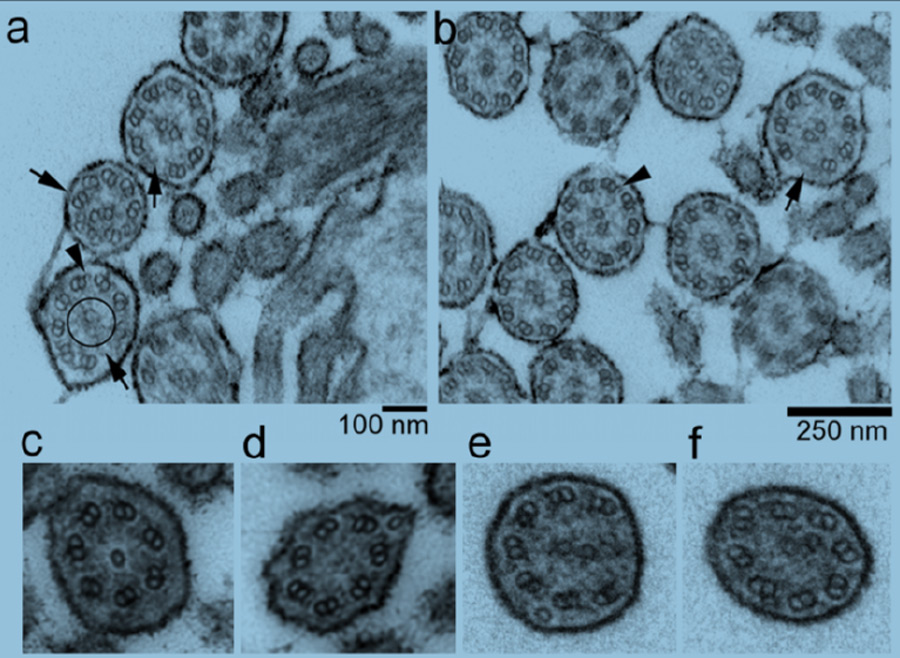Big data study identifies cause for respiratory diseases in cattle
Gene mutation causes juvenile mortality in calves

Respiratory diseases are among the most common ailments in calves. Hubert Pausch from the Chair of Animal Breeding at the Technical University of Munich and his team have now been able to trace a gene mutation responsible in both Braunvieh and Fleckvieh: a recessive mutation that alters the structure of the cilia of the airways is the culprit. It only manifests in homozygous animals. This means that both parents were carriers of the mutation.
The altered structure affects the movement of the cilia, preventing the expulsion of sufficient amounts of secretion from the respiratory tract. Insufficient cleaning of the airways leads to chronic infections. Defective cilia are also the cause of a very rare respiratory disease called primary ciliary dyskinesia in humans.
The study, published in the scientific journal BMC Genomics, was conducted by the TUM Chair of Animal Breeding in collaboration with scientists from the Zentrale Arbeitsgemeinschaft österreichischer Rinderzüchter (Central Working Group of Austrian Cattle Breeders), the Kompetenzzentrums für Informatik & Genetik für Schweizer Zuchtorganisationen (Competence Center for Information Science & Genetics for Swiss Breeders' Organizations) and the cattle hospitals of the Universities of Vienna and Zurich.
Healthy calves are essential for a successful and sustainable cattle breeding. The dominant cattle breeds in southern Germany, Austria, and Switzerland are Fleckvieh and Braunvieh. Fleckvieh produces large quantities of high-quality milk and meat, while Braunvieh is mainly used for milk production.
The entire genome of individual animals of interest to breeders is genotyped, this means, a genetic fingerprint is taken to produce a genetic map. This brings to light individual mutations showing which hereditary characteristics an animal will pass on to its offspring – both positive and negative (such as genetic diseases).
The most comprehensive data analysis in cattle to date
The mutation on chromosome 19 had already been discovered several years ago in Braunvieh. Now it had been found in Fleckvieh as well. “For the first time it has been possible to produce evidence that the gene mutation was highly likely to have been occurred even before the breeds were split into Braunvieh and Fleckvieh”, says Pausch. The team under his helm examined the genome sequences of 290 selected animals and thus several thousands of gigabytes of data generated within this process.
When reviewing the genome databases of cattle breeding associations, Mr. Pausch's team also discovered that the mutation rarely occurred in homozygous animals. “Where both the father and the mother were carriers of the defective gene variant, the survival chances of their offspring was significantly reduced. Homozygous offspring died shortly after birth and was therefore not included in the genome database.”
Difficult search for diseased calves
However, so as to clarify the cause of such high calf mortality, the scientists required the very information about homozygous calves not included in the databases. This meant the team had to identify homozygous animals in time, i.e. immediately after birth to be able to characterize them from a clinical perspective. “Finding the right calves was not easy”, remembers Pausch. Eventually, the scientists managed to find twelve homozygous calves: five were stillborn, three died within 30 days, and four were taken to the cattle hospitals in Vienna and Zurich.
These four calves were significantly underweight and suffered from chronic respiratory diseases. Due to the continuous deterioration of their health the animals had to be put to sleep after a few weeks. The pathological examination showed changes in the structure of cilia inside their airways.
Radical implications of the study for cattle breeding
Since the results of the study were published, breeders have taken carriers of this mutation out of their breeding program. Hubert Pausch considers this decision as “rather radical” and impractical in the medium term. He points out that: “Every individual carries defective genes.” And yet, he concedes he understands the breeding associations’ reaction: “A breeding animal with a very good genetic make-up can result in 10,000, if not 100,000 offspring, so recessive variants such as the mutation on chromosome 19 can very quickly accumulate within a population.” In Pausch’s view, it would be much more prudent to avoid any mating with cows that also carry the gene mutation, given that a heterozygous calf carrying only a variant of the defective gene is not going to develop the disease. Females are currently not being genotyped; something the TUM scientist expects to change in the near future. As soon as female animals are also genotyped across the board, genome-based mating strategies will make it possible to prevent carriers from being paired up. This way mutation carriers of interest for breeders could still be used without heterozygous offspring being born suffering from chronic respiratory diseases.
Publication:
Hermann Schwarzenbacher, Johann Burgstaller, Franz R. Seefried, Christine Wurmser, Monika Hilbe, Simone Jung, Christian Fuerst, Nora Dinhopl, Herbert Weissenböck, Birgit Fuerst-Waltl, Marlies Dolezal, Reinhard Winkler, Oskar Grueter, Ulrich Bleul, Thomas Wittek, Ruedi Fries, Hubert Pausch: A missense mutation in TUBD1 is associated with high juvenile mortality in Braunvieh and Fleckvieh cattle, BMC genomics 2016.
DOI: 10.1186/s12864-016-2742-y
Contact:
Dr. Hubert Pausch
Technische Universität Muenchen
Lehrstuhl fuer Tierzucht
Liesel-Beckmann-Straße 1
D-85354 Freising-Weihenstephan
E-Mail: hubert.pausch@tierzucht.tum.de (contact via mail)
Professor Ruedi Fries
Lehrstuhl für Tierzucht
Technische Universität München
Liesel-Beckmann-Str. 1
85354 Freising
E-Mail: ruedi.fries@tum.de
Tel: +49 8161 713228